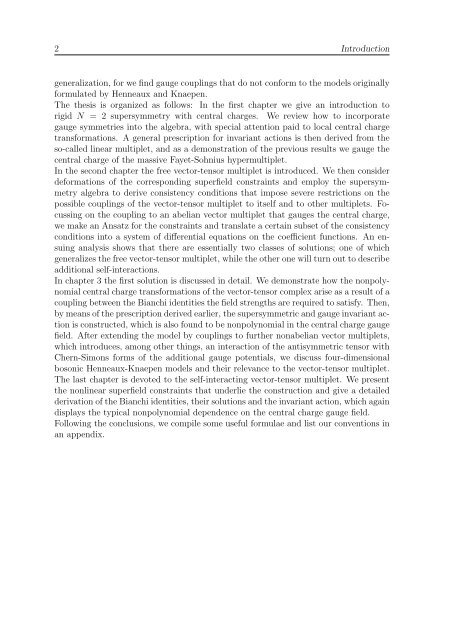N=2 Supersymmetric Gauge Theories with Nonpolynomial Interactions
N=2 Supersymmetric Gauge Theories with Nonpolynomial Interactions
N=2 Supersymmetric Gauge Theories with Nonpolynomial Interactions
You also want an ePaper? Increase the reach of your titles
YUMPU automatically turns print PDFs into web optimized ePapers that Google loves.
2 Introduction<br />
generalization, for we find gauge couplings that do not conform to the models originally<br />
formulated by Henneaux and Knaepen.<br />
The thesis is organized as follows: In the first chapter we give an introduction to<br />
rigid N = 2 supersymmetry <strong>with</strong> central charges. We review how to incorporate<br />
gauge symmetries into the algebra, <strong>with</strong> special attention paid to local central charge<br />
transformations. A general prescription for invariant actions is then derived from the<br />
so-called linear multiplet, and as a demonstration of the previous results we gauge the<br />
central charge of the massive Fayet-Sohnius hypermultiplet.<br />
In the second chapter the free vector-tensor multiplet is introduced. We then consider<br />
deformations of the corresponding superfield constraints and employ the supersymmetry<br />
algebra to derive consistency conditions that impose severe restrictions on the<br />
possible couplings of the vector-tensor multiplet to itself and to other multiplets. Focussing<br />
on the coupling to an abelian vector multiplet that gauges the central charge,<br />
we make an Ansatz for the constraints and translate a certain subset of the consistency<br />
conditions into a system of differential equations on the coefficient functions. An ensuing<br />
analysis shows that there are essentially two classes of solutions; one of which<br />
generalizes the free vector-tensor multiplet, while the other one will turn out to describe<br />
additional self-interactions.<br />
In chapter 3 the first solution is discussed in detail. We demonstrate how the nonpolynomial<br />
central charge transformations of the vector-tensor complex arise as a result of a<br />
coupling between the Bianchi identities the field strengths are required to satisfy. Then,<br />
by means of the prescription derived earlier, the supersymmetric and gauge invariant action<br />
is constructed, which is also found to be nonpolynomial in the central charge gauge<br />
field. After extending the model by couplings to further nonabelian vector multiplets,<br />
which introduces, among other things, an interaction of the antisymmetric tensor <strong>with</strong><br />
Chern-Simons forms of the additional gauge potentials, we discuss four-dimensional<br />
bosonic Henneaux-Knaepen models and their relevance to the vector-tensor multiplet.<br />
The last chapter is devoted to the self-interacting vector-tensor multiplet. We present<br />
the nonlinear superfield constraints that underlie the construction and give a detailed<br />
derivation of the Bianchi identities, their solutions and the invariant action, which again<br />
displays the typical nonpolynomial dependence on the central charge gauge field.<br />
Following the conclusions, we compile some useful formulae and list our conventions in<br />
an appendix.

















